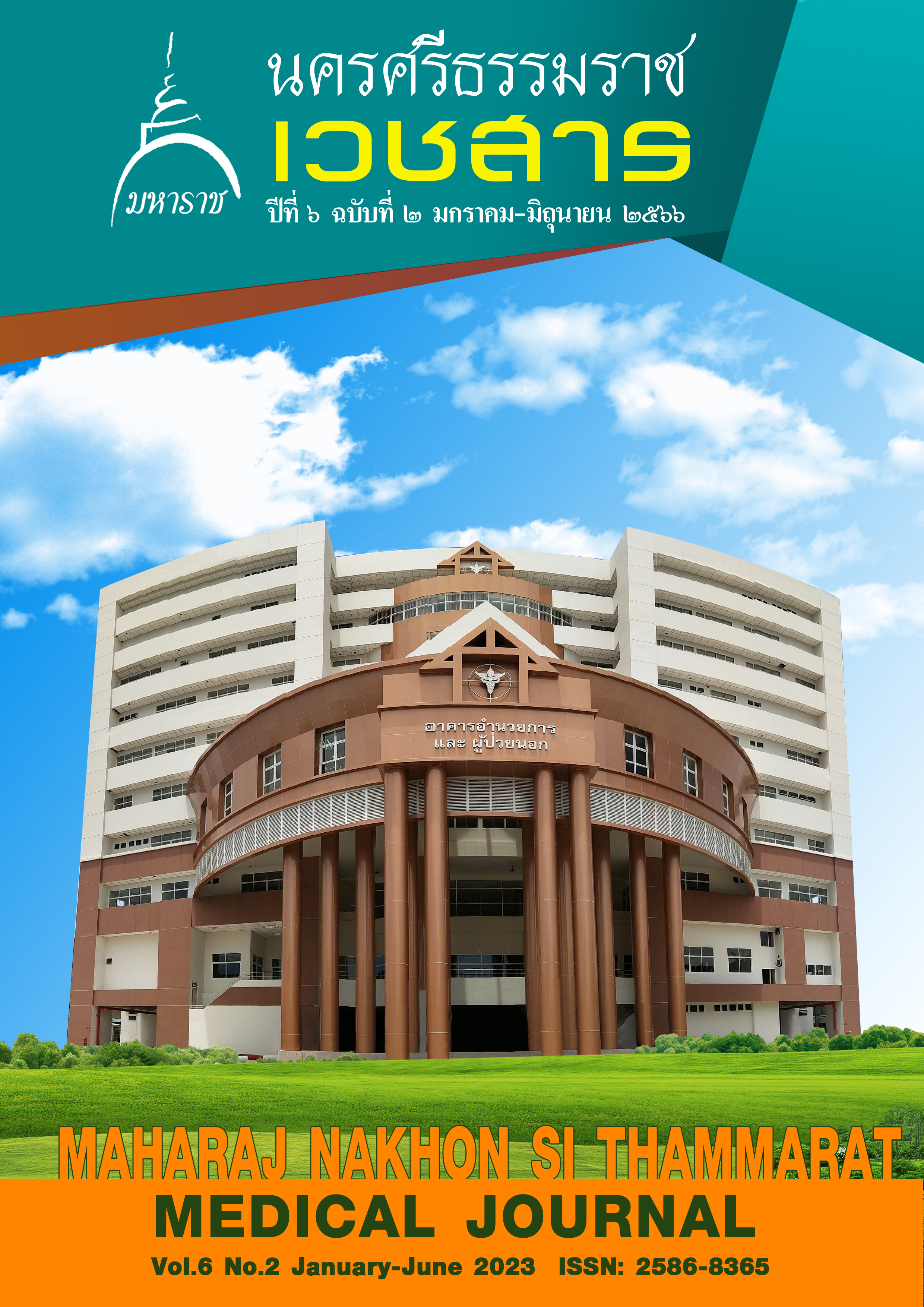เชื้อก่อโรคที่พบในกระแสเลือดในผู้ป่วยที่มีภาวะไข้จากระดับเม็ดเลือดขาวชนิดนิวโตรฟิลต่ำ ในโรงพยาบาลมหาราชนครศรีธรรมราช
คำสำคัญ:
ภาวะไข้จากระดับเม็ดเลือดขาวชนิดนิวโตรฟิลต่ำ, เชื้อก่อโรคการติดเชื้อในกระแสเลือดบทคัดย่อ
บทนำ : ภาวะไข้จากระดับเม็ดเลือดขาวชนิดนิวโตรฟิลต่ำ เป็นภาวะแทรกซ้อนที่พบได้บ่อยและส่งผลต่ออัตราการตายในผู้ป่วยมะเร็งที่ได้รับยาเคมีบำบัด ซึ่งเชื้อก่อโรคมีความหลากหลายในแต่ละพื้นที่ ดังนั้นการทราบเชื้อก่อโรคประจำถิ่นมีผลต่อการตัดสินใจเลือกใช้ยาปฏิชีวนะเบื้องต้น
วัตถุประสงค์ : เพื่อศึกษาชนิดของเชื้อก่อโรคที่พบในกระแสเลือดในผู้ป่วยที่มีภาวะไข้จากระดับเม็ดเลือดขาวชนิดนิวโทรฟิลต่ำและรูปแบบความไวของเชื้อต่อยาปฏิชีวนะในโรงพยาบาลมหาราชนครศรีธรรมราช
วัสดุและวิธีการศึกษา : เป็นการศึกษาย้อนหลังเชิงพรรณนาโดยการเก็บข้อมูลย้อนหลังเกี่ยวกับเชื้อก่อโรคแบคทีเรียและเชื้อราในกระแสเลือดของผู้ป่วย ในโรงพยาบาลมหาราชนครศรีธรรมราชตั้งแต่เดือน มกราคม พ.ศ. 2563 –มิถุนายนพ.ศ. 2565
ผลการศึกษา : มีภาวะไข้จากระดับเม็ดเลือดขาวชนิดนิวโตรฟิลต่ำ 133 ครั้ง ในผู้ป่วย 79 ราย พบการติดเชื้อในกระแสเลือด 29 ครั้ง (ร้อยละ 22) โดยเชื้อในกระแสเลือดที่พบเป็นเชื้อแบคทีเรียแกรมลบ 25 ครั้ง (ร้อยละ86.2) และแบคทีเรียแกรมบวก 4 ครั้ง (ร้อยละ 13.8) เชื้อก่อโรคที่พบบ่อย ได้แก่ E. coli, K.pneumoniae, P. aeruginosa และ Bacillusspp.โดยเชื้อแบคทีเรียแกรมลบไม่พบเชื้อดื้อยา แต่พบ methicillin-resistantCoagulase-negativeStaphylococci(MRCoNs)1 ราย นอกจากนี้พบการติดเชื้อรา ร้อยละ10ได้แก่เชื้อ Aspergillusspp.ร้อยละ7.5 และ Candidaspp. ร้อยละ 2.3 ระยะเวลานอนโรงพยาบาล 10 วัน และอัตราการตาย ร้อยละ10.5
สรุป : ผู้ป่วยที่มีภาวะไข้จากระดับเม็ดเลือดขาวชนิดนิวโตรฟิลต่ำในโรงพยาบาลมหาราชนครศรีธรรมราชพบว่าเชื้อก่อโรคที่พบในกระแสเลือดส่วนใหญ่เป็นเชื้อแบคทีเรียแกรมลบเป็นหลัก และพบเชื้อดื้อยาน้อย ดังนั้นแพทย์สามารถเลือกใช้ยาปฏิชีวนะที่เหมาะสมและสอดคล้องกับเชื้อประจำถิ่นได้อย่างถูกต้อง
เอกสารอ้างอิง
Lakshmaiah KC, Malabagi AS, Govindbabu, Shetty R, Sinha M, Jayashree RS. Febrile Neutropenia in Hematological Malignancies: Clinical and Microbiological Profile and Outcome in High Risk Patients. J Lab Physicians 2015;7(2):116-20.
Klastersky J, de Naurois J, Rolston K, Rapoport B, Maschmeyer G, Aapro M, et al.; ESMO Guidelines Committee. Management of febrile neutropaenia: ESMO Clinical Practice Guidelines. Ann Oncol 2016;27(suppl 5):v111-8.
Na-Nakorn T, Intragumtornchai T. Management of patients with febrile neutropenia. Chula Med J 1994;38(12): 771-86
Paul M, Bhatia M, Rekha US, Diksha 1, Omar BJ, Gupta P. Microbiological Profile of Blood Stream Infections in Febrile Neutropenic Patients at a Tertiary Care Teaching Hospital in Rishikesh, Uttarakhand. J Lab Physicians 2020;12(2):147-53.
Swati M, Gita N, Sujata B, Farah J, Preeti M. Microbial etiology of febrile neutropenia. Indian J Hematol Blood Transfus 2010;26(2):49-55.
Kanamaru A, Tatsumi Y. Microbiological data for patients with febrile neutropenia. Clin Infect Dis 2004;39(Suppl 1):S7-10.
Rasmy A, Amal A, Fotih S, Selwi W. Febrile Neutropenia in Cancer Patient: Epidemiology, Microbiology, Pathophysiology and Management. J Cancer PrevCurr Res 2016;5(3):00165.
Chayakulkeeree M, Thamlikitkul V. Risk index for predicting complications and prognosis in Thai patients with neutropenia and fever. J Med Assoc Thai 2003;86(3):212-23.
Sereeaphinan C, Kanchanasuwan S, Julamanee J. Mortality-associated clinical risk factors in patients with febrile neutropenia: A retrospective study, IJID Regions2021,(1)5-11.
Alison G,Freifeld, Eric J, Bow, Kent A,Sepkowitz, et al. Clinical Practice Guideline for the Use of Antimicrobial Agents in Neutropenic Patients with Cancer: 2010 Update by the Infectious Diseases Society of America, Clin Infect Dis 2011;52(4): e56–93.
Escrihuela-Vidal F, Laporte J, Albasanz-Puig A, Gudiol C. Update on the management of febrile neutropenia in hematologic patients. Rev EspOuimioter 2019;32(Suppl2):55-8.
Trecarichi EM, Pagano L, Martino B, Candoni A, Di Blasi R, Nadali G, et al. Bloodstream infections caused by Klebsiellapneumoniae in onco-hematological patients: clinical impact of carbapenem re¬sistance in a multicentre prospective survey. Am J Hematol 2016; 91(11):1076-81.
Osmani AH, Jabbar AA, Gangwani MK, Hassan B. Outcomes of High Risk Patients with Febrile Neutropenia at a Tertiary Care Center. Asian Pac J Cancer Prev 2017;18(10) :2741-5.
ดาวน์โหลด
เผยแพร่แล้ว
รูปแบบการอ้างอิง
ฉบับ
ประเภทบทความ
สัญญาอนุญาต

อนุญาตภายใต้เงื่อนไข Creative Commons Attribution-NonCommercial-NoDerivatives 4.0 International License.
เนื้อหาและข้อมูลในบทความที่ลงตีพิมพ์ในมหาราชนครศรีธรรมราชเวชสาร ถือเป็นข้อคิดเห็นและความรับผิดชอบของผู้เขียนบทความโดยตรงซึ่งกองบรรณาธิการวารสาร ไม่จำเป็นต้องเห็นด้วย หรือร่วมรับผิดชอบใด ๆ
บทความ ข้อมูล เนื้อหา รูปภาพ ฯลฯ ที่ได้รับการตีพิมพ์ในมหาราชนครศรีธรรมราชเวชสาร ถือเป็นลิขสิทธิ์ของมหาราชนครศรีธรรมราชเวชสาร หากบุคคลหรือหน่วยงานใดต้องการนำทั้งหมดหรือส่วนหนึ่งส่วนใดไปเผยแพร่ต่อหรือเพื่อกระทำการใด จะต้องได้รับอนุญาตเป็นลายลักษณ์อักษรจากวารสารมหาราชนครศรีธรรมราชเวชสาร ก่อนเท่านั้น



